One reason I love herpetology is because there is always so much more to learn and plenty of surprises to be had even after years of working with reptiles and amphibians. While I am familiar with a huge number of herptile species found all over the world, it's not uncommon for me to learn about new species I've never even heard of or considered. This post is about one such animal; I was watching a documentary the other night which briefly followed an unusual snake, the likes of which I had never seen nor heard of. This particular snake employs a strange hunting tactic that makes it remarkable successful.
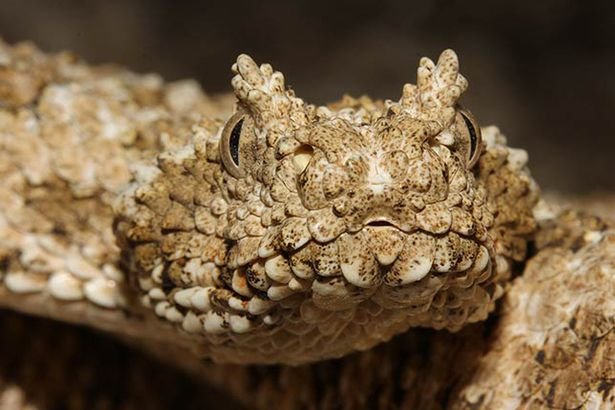
In the early 2000's, curators at the Field Museum of Natural History in Chicago were going through their collection when they came across an odd preserved animal. It was a species of horned viper, one that had been collected in 1968 during the Second Street Expedition to Iran and had been residing at the museum for decades. All in all, the horned viper appeared like any other horned viper species out there...until one looked at the tail. Rather than the usual pointed tapering of a snake tail, this viper had a bulbous tail surrounded by long scaly spikes.
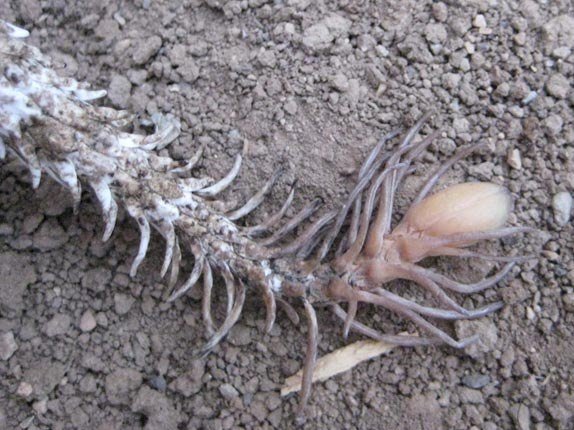
This is, of course, not at all what one would expect to find when looking at the tail of a snake. The herpetologists studying the specimen debated over whether this could be a single bizarre anomaly or perhaps a species not yet known to the world of herpetology. If it was a new species, what could such an alien-looking adaptation be for?
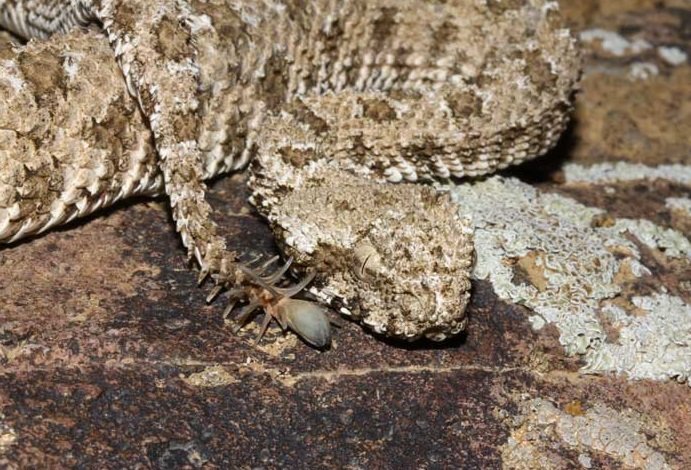
The herpetologists speculated that if such an appendage was normal for the animal, it likely had to be used to capture prey, essentially some form of caudal lure (you can read my past post about snakes luring prey here). Caudal luring is a tactic used by many species of snakes to encourage prey to enter striking distance; by wiggling their tail in an enticing manner, they will draw prey closer to increase their chances of success. Animals, such as birds, mistake the lure for a wiggling worm or small insect and move in to snatch it up, only to become a meal themselves. It was noted that with the long spines surrounding the tail of this viper, the lure almost looked like a large spider, and herpetologists hypothesized that the snake hunted birds who fed on arthropods. Lying motionless, the snake is almost invisible, so prey would never see the snake as they swept in for the lure.
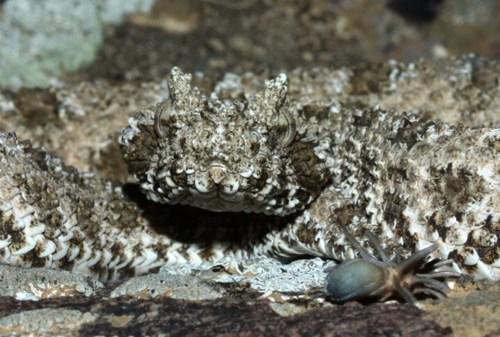
It was only later that the hunting tactic was observed and filmed in the wild. The tail was indeed used as a lure, but far more effectively than anyone had imagined. Perhaps the most well-adapted caudal lure in the snake world, the viper actually wiggled its tail to perfectly mimic the movement of a spider. Just a short video easily shows the efficiency of their strange appendage. (This video completely blew my mind!).
In 2006, the species was officially described as the Iranian Spider-Tailed Horned Viper. Though perhaps a worst nightmare for arachnophobes and ophibiophobes (those who fear snakes), this horned viper displays one of the most remarkable adaptations in the reptile world, giving it a massive advantage in a land where food can be quite scarce.
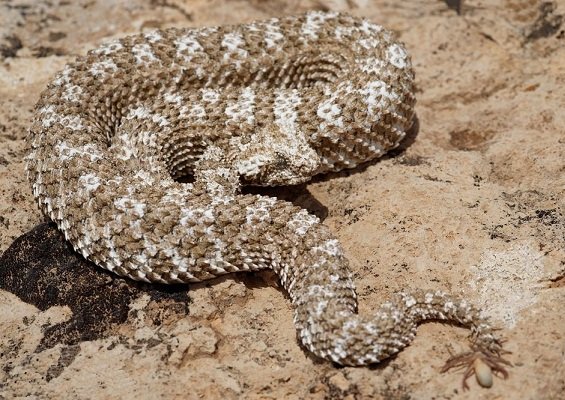
Video Links: 1

Remind me to avoid this snake
That is some dangerous camouflage. I wonder what it would do if a human was lured into its strike zone.
As long as a person didn't mess with it or step on it, it probably wouldn't do much. Obviously a human isn't its natural prey so it really wouldn't want to tangle with a person (it sees US as dangerous!). If the snake can remain undetected, that is probably what it will do, and only attempt to defend itself if it is scared or has no other options.
It's funny that both humans and snakes think alike. I think the best course of action for a human would be to slowly walk away from it without panicking.
That is a really impressive snake. You're right, it truly mimics a spider's motion exactly. Coupled with it's remarkable camouflage this truly is a king killer.
Unfortunately, I could not find the video I saw on tv, but I didn't even SEE the snake until it struck. And the narrator didn't mention the snake, so I was convinced I was just looking at a spider until a bird swooped down and got nailed!
Astonishing. I never seen that one before. It can make you really wonder, what kind of evolutionary process is neccessary to develope something like that.
I mean, the ancestors of those snakes did not get born suddenly with a spider dummy on their tail. So what actually happened, and from which point on it began to be useful for the snake? And how long did it take? Truely strange.
Like any other adaptation, it was probably just a bizarre sequence of mutations! But dang if it didn't create a masterpiece of a lure!
It certainly is. But it sure didn't mutate to the current form over night, and on top of that, the snakes had to learn how to use it so convincingly. Thats what I wonder about, how the snake benefited from it in the early stages, in order to get a evolutionary advantage to have time to develope this further until this stage of perfection. Would be really interesting to see how this happened, and how long it took.
It would have to have taken an insanely long time. Most snakes that display caudal luring have a normal tail that, at most, has taken on a different color to attract prey. In order to develop the large bulb and spikes, it would definitely have taken quite a few generations, and likely just started when one snake had a slightly spikier tail. But I think, if I had to wager a guess, that the behavior came first; the tail movements are actually quite similar to other snake species and I think that the spines grew to make the luring even more eye catching.
It is still hard to comprehend how this can happen, all by coincidence. At least it must have taken a very long time, perhaps millions of years. I mean, the snakes previously were also able to survive, so it wouldn't be a must to have this feature in order to survive, just a little advantage.
It would be really helpful to find fossils of snakes with different degrees of developement of this feature. But thats not so easy, I guess.
True, the desert isn't especially conducive to fossilization, so finding the missing links here could prove challenging. But I'll bet there are a few out there is we look hard enough.
Woaaaah. The fisher snake. Fishing birds.
At the begging I really thought it was an insect running on him. That's totally amazing. Nature never cease to amaze me...
Thanks for sharing your passion. :)
The movement is incredible isn't it? I'm not surprised it lures prey in with such efficiency!
My mouth was literally agape during that video. It did look just like a spider! That is crazy! Awesome post. RESTEEMED!
As someone with a phobia of snakes AND spiders, this was intense to watch and absorb with both of my fears addressed in one shot. Nature is brilliant in its evolution. That bird was not too bright to come in for a second swoop. Natural selection? Why on earth wouldn't the bird's instincts tell it to let the snack go with the deadly snake missing its first strike?
Because of the snake's camouflage, I'll bet the bird didn't really realize its life was in danger even after the viper moved. If the bird was focused on the lure, it's very likely that it thought it was dodging some falling rocks or other inanimate object and returned to capture the prey when it felt safe. That's my best explanation because most birds will absolutely flip out as soon as they locate a snake and will warn other birds nearby, but this bird did not give any of the usual warning signals.
First time I hear of this amazing viper! Always fascinating to read about the weird stuff mother nature comes up with. Upvoted and resteemed (not that it matters much cause this is a new account :P)
after watching this, i am not going to trust a single spider, as it might be this snake.
Lol, well this guy lives in the deserts of Iran and is really rare (the behavior wasn't even filmed in the wild until 2014), so you are pretty safe!
Congratulations! Your post has been curated by the @steemstem team and has been featured on SteemStem Distilled #1: https://steemit.com/steemstem/@steemstem/introducing-steemstem-distilled-1
Thank you!
Thank you for the update really dangerous.
Omg the picture look crazy
Incredible creature! Nice info Sir.
Never seen a snake like that before. Amazing....
@herpetologyguy Our post today is the same. https://steemit.com/fhotografhy/@lelek/snake-fhotografhy-2017924t131453994z
Ahh..very scary..and this will be a worst nightmare for me..
This is incredible! Love it. @herpetologyguy
Damn!
WOW! That video is amazing! It's a great lure, really sophisticated
This is an amazing and interesting snake, I loved this post.
dangerous camouflage
man nature is like an arms race
These posts are really worth it. I went through some of them and I must say; they are perfect combination of scientific ingenuity and creative acumen.
Well written and informative. Thank you for posting this. Steem On! :)
Resteemed.
Spamming comments is frowned upon by the community.
Continued comment spamming may result in action from the cheetah bot.